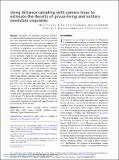Using distance sampling with camera traps to estimate the density of group-living and solitary mountain ungulates
Abstract
Throughout the Himalaya, mountain ungulates are threatened by hunting for meat and body parts, habitat loss, and competition with livestock. Accurate population estimates are important for conservation management but most of the available methods to estimate ungulate densities are difficult to implement in mountainous terrain. Here, we tested the efficacy of the recent extension of the point transect method, using camera traps for estimating density of two mountain ungulates: the group-living Himalayan blue sheep or bharal Pseudois nayaur and the solitary Himalayan musk deer Moschus leucogaster. We deployed camera traps in 2017-2018 for the bharal (summer: 21 locations; winter: 25) in the trans-Himalayan region (3,000-5,000 m) and in 2018-2019 for the musk deer (summer: 30 locations; winter: 28) in subalpine habitats (2,500-3,500 m) in the Upper Bhagirathi basin, Uttarakhand, India. Using distance sampling with camera traps, we estimated the bharal population to be 0.51 ± SE 0.1 individuals/km2 (CV = 0.31) in summer and 0.64 ± SE 0.2 individuals/km2 (CV = 0.37) in winter. For musk deer, the estimated density was 0.4 ± SE 0.1 individuals/km2 (CV = 0.34) in summer and 0.1 ± SE 0.05 individuals/km2 (CV = 0.48) in winter. The high variability in these estimates is probably a result of the topography of the landscape and the biology of the species. We discuss the potential application of distance sampling with camera traps to estimate the density of mountain ungulates in remote and rugged terrain, and the limitations of this method.
Citation
Pal , R , Bhattacharya , T , Qureshi , Q , Buckland , S T & Sathyakumar , S 2021 , ' Using distance sampling with camera traps to estimate the density of group-living and solitary mountain ungulates ' , Oryx , vol. FirstView . https://doi.org/10.1017/S003060532000071X
Publication
Oryx
Status
Peer reviewed
ISSN
0030-6053Type
Journal article
Description
This work is part of a project initiated under the National Mission for Sustaining the Himalayan Ecosystem (NMSHE) Programme funded by the Department of Science and Technology, Government of India (grant no.: DST/SPLICE/CCP/NMSHE/TF-2/WII/2014[G]). The Miriam Rothschild Travel Bursary Programme provided funding for a 4-week internship for R. Pal with S.T. Buckland at St Andrews University, UK.Collections
Items in the St Andrews Research Repository are protected by copyright, with all rights reserved, unless otherwise indicated.

